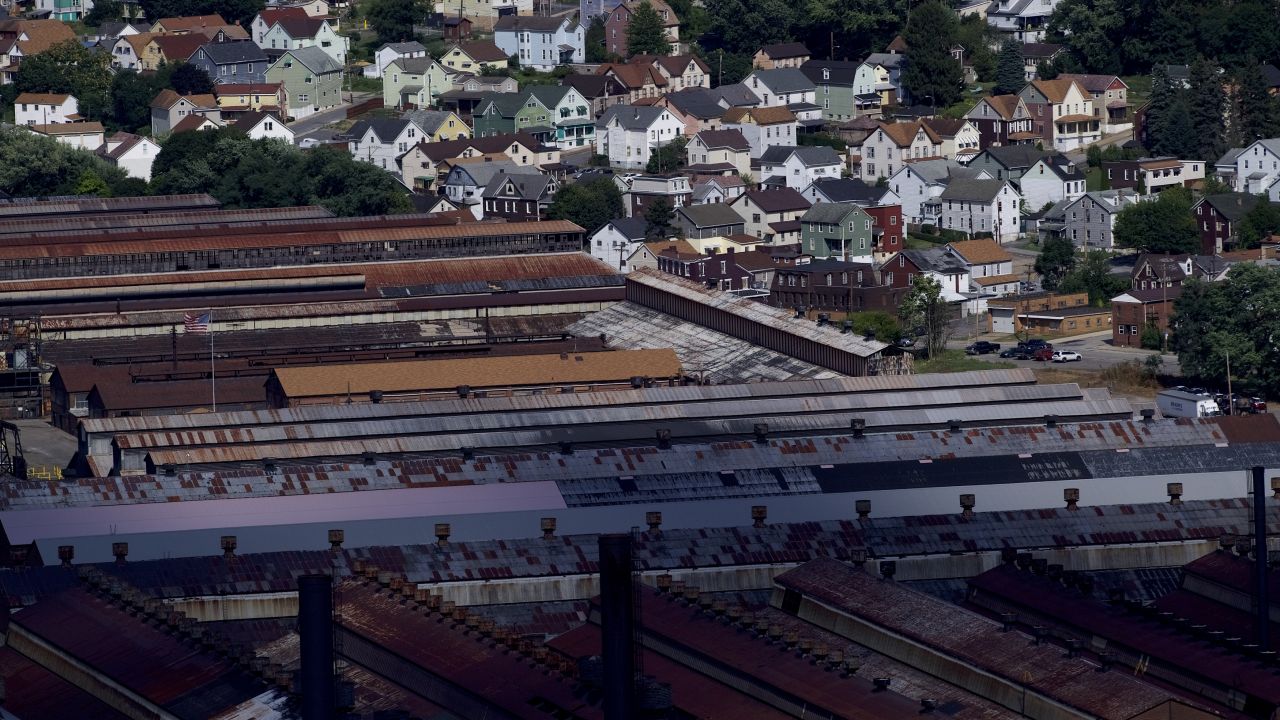
Residences outside the shuttered Cambria Iron Company steelworks in Johnstown, Pennsylvania, a state where Donald Trump hopes to convince economically dislocated Democrats to vote for him. (Photo by Mark Makela/Getty Images)
Every four years, the white working class gets a fresh round of attention from candidates and the media. At campaign stops in Rust Belt cities, candidates promise to fix the economy, while pundits yet again claim that white working-class voters are the key to election victory. The pattern is being repeated this year, but this time, both the news media and social media seem especially baffled by the attitudes and behavior of working-class voters.
As a number of commentators have noted, the roots of this year’s populism lie in deindustrialization, though some seem baffled that white working-class people are still troubled by either NAFTA, which went into effect in 1994, or the loss of industrial jobs, which peaked in the early 1980s. In a recent New York Times column, David Brooks suggested that working-class people should not be so strongly affected by the economic hardship of deindustrialization. After all, he suggested, it’s not as if life in a coal town was ever easy. What he and others don’t realize is that deindustrialization was never only about economics. Its economic, social and psychological effects continue for decades after plants closed and across generations, affecting the worldviews of younger people who never worked in steel mills or auto plants. Like radioactive waste, deindustrialization has a half-life.
More than three decades after the waves of plant closings that made deindustrialization international news in the late 1970s and ’80s, people living in former industrial areas still feel the loss of good jobs. Many have found work, some still in manufacturing, but they earn less and, in many cases, their hours have become less steady; they’ve been forced to pay more for health care; and the work itself has become less meaningful – in part because workers are more conscious than ever that it might be temporary.
The half-life of deindustrialization plays out socially too. The social networks that developed around industrial work have fragmented. Some people moved away in search of work, while those who stayed lost the daily interaction with co-workers. Once-solid neighborhoods became marked with empty lots and abandoned houses, and local businesses closed up or kept changing, undermining the sense of stability and connection that makes communities strong. People lost faith in institutions as corporations, unions, government and even churches all proved unable to respond adequately to an economic and political shift that was much larger and more significant than anyone realized. Over time, communities internalized these losses, and many places like Youngstown, Detroit and Flint continue to wrestle not only with the loss of their economic base but also with a loss of civic identity.
Individuals have also internalized these struggles. For some, decades of economic struggle and the deterioration of community have brought a sense of isolation, so that people feel that they can depend only on themselves. Sociologist Jennifer Silva suggests that many working-class people are now defining their identities through what she calls “therapeutic narratives,” stories about their individual triumphs over personal traumas like family dysfunctions, drug addiction or the struggle to get through college while working full-time. For others, the half-life of deindustrialization brings a more painful perspective. They see themselves as losers, as people who, for reasons they can’t always articulate, somehow deserve nothing more than a low-wage, insecure job and persistent economic vulnerability. And for some, as we’ve seen in so much election coverage, the displacement of deindustrialization is now surfacing in the form of anger and resentment – of politicians, of immigrants, of those who seem to be thriving in the contemporary economy.
Like the effects of radiation poisoning, the injuries associated with the half-life of deindustrialization may remain hidden for a long while, surfacing only when they take more serious form. Over the past year, we’ve begun to notice how deindustrialization is, over the course of decades, generating both real illnesses in the form of rising rates of suicide, drug addiction and death and a kind of social dis-ease, a sense of having been excluded from the America that once seemed to offer white male industrial workers real opportunities to gain the economic stability and social position embodied in the American Dream.
As this campaign season rolls on, we will likely continue to see educated elites try to diagnose the white working class. Too often, especially in social media, that takes the form of denigrating their intelligence and character. If Hillary Clinton wins in November, many who are now trying to understand the attitudes and experiences of the white working class will turn their attention elsewhere. But the anger and frustration that animates so many of Donald Trump’s supporters will not go away when this election ends. We don’t yet know how long the half-life of deindustrialization will last, but we can be sure that it will not end on Nov. 8.




